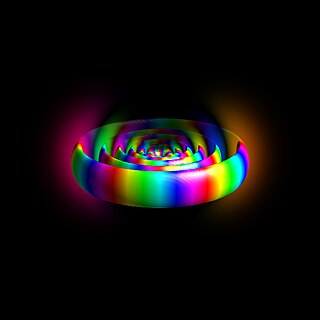
Thorium is a chemical element. It has the symbol Th and atomic number 90. Thorium is a weakly radioactive light silver metal which tarnishes olive gray when it is exposed to air, forming thorium dioxide; it is moderately soft and malleable and has a high melting point. Thorium is an electropositive actinide whose chemistry is dominated by the +4 oxidation state; it is quite reactive and can ignite in air when finely divided.

Laser cooling includes several techniques where atoms, molecules, and small mechanical systems are cooled with laser light. The directed energy of lasers is often associated with heating materials, e.g. laser cutting, so it can be counterintuitive that laser cooling often results in sample temperatures approaching absolute zero. It is a routine step in many atomic physics experiments where the laser-cooled atoms are then subsequently manipulated and measured, or in technologies, such as atom-based quantum computing architectures. Laser cooling relies on the change in momentum when an object, such as an atom, absorbs and re-emits a photon. For example, if laser light illuminates a warm cloud of atoms from all directions and the laser's frequency is tuned below an atomic resonance, the atoms will be cooled. This common type of laser cooling relies on the Doppler effect where individual atoms will preferentially absorb laser light from the direction opposite to the atom's motion. The absorbed light is re-emitted by the atom in a random direction. After repeated emission and absorption of light the net effect on the cloud of atoms is that they will expand more slowly. The slower expansion reflects a decrease in the velocity distribution of the atoms, which corresponds to a lower temperature and therefore the atoms have been cooled. For an ensemble of particles, their thermodynamic temperature is proportional to the variance in their velocity, therefore the lower the distribution of velocities, the lower temperature of the particles.

A nuclear isomer is a metastable state of an atomic nucleus, in which one or more nucleons (protons or neutrons) occupy excited state (higher energy) levels. "Metastable" describes nuclei whose excited states have half-lives 100 to 1000 times longer than the half-lives of the excited nuclear states that decay with a "prompt" half life (ordinarily on the order of 10−12 seconds). The term "metastable" is usually restricted to isomers with half-lives of 10−9 seconds or longer. Some references recommend 5 × 10−9 seconds to distinguish the metastable half life from the normal "prompt" gamma-emission half-life. Occasionally the half-lives are far longer than this and can last minutes, hours, or years. For example, the 180m
73Ta
nuclear isomer survives so long (at least 1015 years) that it has never been observed to decay spontaneously. The half-life of a nuclear isomer can even exceed that of the ground state of the same nuclide, as shown by 180m
73Ta
as well as 186m
75Re
, 192m2
77Ir
, 210m
83Bi
, 212m
84Po
, 242m
95Am
and multiple holmium isomers.

Electromagnetically induced transparency (EIT) is a coherent optical nonlinearity which renders a medium transparent within a narrow spectral range around an absorption line. Extreme dispersion is also created within this transparency "window" which leads to "slow light", described below. It is in essence a quantum interference effect that permits the propagation of light through an otherwise opaque atomic medium.

A Rydberg atom is an excited atom with one or more electrons that have a very high principal quantum number, n. The higher the value of n, the farther the electron is from the nucleus, on average. Rydberg atoms have a number of peculiar properties including an exaggerated response to electric and magnetic fields, long decay periods and electron wavefunctions that approximate, under some conditions, classical orbits of electrons about the nuclei. The core electrons shield the outer electron from the electric field of the nucleus such that, from a distance, the electric potential looks identical to that experienced by the electron in a hydrogen atom.

A trapped-ion quantum computer is one proposed approach to a large-scale quantum computer. Ions, or charged atomic particles, can be confined and suspended in free space using electromagnetic fields. Qubits are stored in stable electronic states of each ion, and quantum information can be transferred through the collective quantized motion of the ions in a shared trap. Lasers are applied to induce coupling between the qubit states or coupling between the internal qubit states and the external motional states.
In physics, induced gamma emission (IGE) refers to the process of fluorescent emission of gamma rays from excited nuclei, usually involving a specific nuclear isomer. It is analogous to conventional fluorescence, which is defined as the emission of a photon by an excited electron in an atom or molecule. In the case of IGE, nuclear isomers can store significant amounts of excitation energy for times long enough for them to serve as nuclear fluorescent materials. There are over 800 known nuclear isomers but almost all are too intrinsically radioactive to be considered for applications. As of 2006 there were two proposed nuclear isomers that appeared to be physically capable of IGE fluorescence in safe arrangements: tantalum-180m and hafnium-178m2.
Uranium (92U) is a naturally occurring radioactive element that has no stable isotope. It has two primordial isotopes, uranium-238 and uranium-235, that have long half-lives and are found in appreciable quantity in the Earth's crust. The decay product uranium-234 is also found. Other isotopes such as uranium-233 have been produced in breeder reactors. In addition to isotopes found in nature or nuclear reactors, many isotopes with far shorter half-lives have been produced, ranging from 214U to 242U. The standard atomic weight of natural uranium is 238.02891(3).
Thorium (90Th) has seven naturally occurring isotopes but none are stable. One isotope, 232Th, is relatively stable, with a half-life of 1.405×1010 years, considerably longer than the age of the Earth, and even slightly longer than the generally accepted age of the universe. This isotope makes up nearly all natural thorium, so thorium was considered to be mononuclidic. However, in 2013, IUPAC reclassified thorium as binuclidic, due to large amounts of 230Th in deep seawater. Thorium has a characteristic terrestrial isotopic composition and thus a standard atomic weight can be given.
Meitnerium (109Mt) is a synthetic element, and thus a standard atomic weight cannot be given. Like all synthetic elements, it has no stable isotopes. The first isotope to be synthesized was 266Mt in 1982, and this is also the only isotope directly synthesized; all other isotopes are only known as decay products of heavier elements. There are eight known isotopes, from 266Mt to 278Mt. There may also be two isomers. The longest-lived of the known isotopes is 278Mt with a half-life of 8 seconds. The unconfirmed heavier 282Mt appears to have an even longer half-life of 67 seconds.
Darmstadtium (110Ds) is a synthetic element, and thus a standard atomic weight cannot be given. Like all synthetic elements, it has no stable isotopes. The first isotope to be synthesized was 269Ds in 1994. There are 11 known radioisotopes from 267Ds to 281Ds and 2 or 3 known isomers. The longest-lived isotope is 281Ds with a half-life of 14 seconds.
Flerovium (114Fl) is a synthetic element, and thus a standard atomic weight cannot be given. Like all synthetic elements, it has no stable isotopes. The first isotope to be synthesized was 289Fl in 1999. Flerovium has six known isotopes, along with the unconfirmed 290Fl, and possibly two nuclear isomers. The longest-lived isotope is 289Fl with a half-life of 1.9 seconds, but 290Fl may have a longer half-life of 19 seconds.
Moscovium (115Mc) is a synthetic element, and thus a standard atomic weight cannot be given. Like all synthetic elements, it has no known stable isotopes. The first isotope to be synthesized was 288Mc in 2004. There are five known radioisotopes from 286Mc to 290Mc. The longest-lived isotope is 290Mc with a half-life of 0.65 seconds.
Livermorium (116Lv) is an artificial element, and thus a standard atomic weight cannot be given. Like all artificial elements, it has no stable isotopes. The first isotope to be synthesized was 293Lv in 2000. There are five known radioisotopes, with mass numbers 288 and 290–293, as well as a few suggestive indications of a possible heavier isotope 294Lv. The longest-lived known isotope is 293Lv with a half-life of 70 ms.
In spectroscopy, a forbidden mechanism is a spectral line associated with absorption or emission of photons by atomic nuclei, atoms, or molecules which undergo a transition that is not allowed by a particular selection rule but is allowed if the approximation associated with that rule is not made. For example, in a situation where, according to usual approximations, the process cannot happen, but at a higher level of approximation the process is allowed but at a low rate.
In condensed matter physics, an ultracold atom is an atom with a temperature near absolute zero. At such temperatures, an atom's quantum-mechanical properties become important.

The nitrogen-vacancy center is one of numerous photoluminescent point defects in diamond. Its most explored and useful properties include its spin-dependent photoluminescence, and its relatively long (millisecond) spin coherence at room temperature. The NV center energy levels are modified by magnetic fields, electric fields, temperature, and strain, which allow it to serve as a sensor of a variety of physical phenomena. Its atomic size and spin properties can form the basis for useful quantum sensors. It has also been explored for applications in quantum computing, quantum simulation, and spintronics.

An atomic clock is a clock that measures time by monitoring the resonant frequency of atoms. It is based on atoms having different energy levels. Electron states in an atom are associated with different energy levels, and in transitions between such states they interact with a very specific frequency of electromagnetic radiation. This phenomenon serves as the basis for the International System of Units' (SI) definition of a second:
The second, symbol s, is the SI unit of time. It is defined by taking the fixed numerical value of the caesium frequency, , the unperturbed ground-state hyperfine transition frequency of the caesium-133 atom, to be 9192631770 when expressed in the unit Hz, which is equal to s−1.
Double ionization is a process of formation of doubly charged ions when laser radiation is exerted on neutral atoms or molecules. Double ionization is usually less probable than single-electron ionization. Two types of double ionization are distinguished: sequential and non-sequential.

Patrick Gill is a Senior NPL Fellow in Time & Frequency at the National Physical Laboratory (NPL) in the UK.









